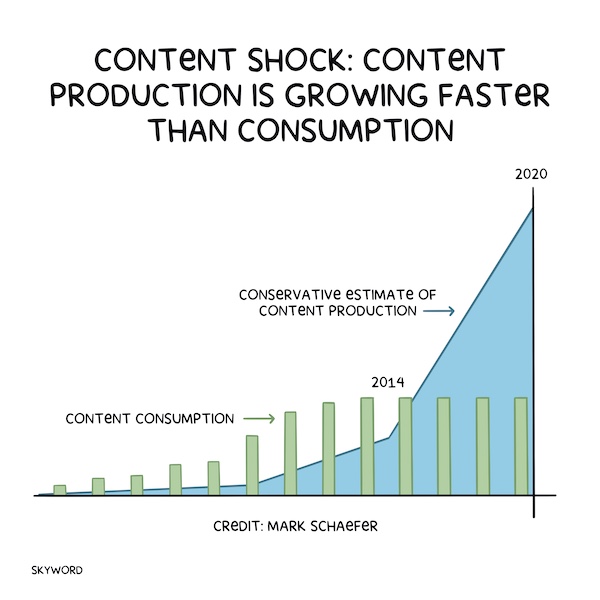Content Creation
How to Thrive in the Content Shock Era: Your Brand’s Future Depends on It
By Andrew Wheeler on January 3, 2023
Michael Schaefer first coined the concept of Content Shock in January 2014. In a blog post, he predicted that well before 2020, the sheer quantity of content being produced by businesses would vastly outpace people's ability to consume it.

He argued that this supply/demand imbalance would create an unimaginably challenging marketing environment. One in which audiences would be overwhelmed by the amount of content they're exposed to while the "cost" for marketers to cut through the noise would become unsustainable.
Sound familiar?
In the beginning, intense competition drove brands to double down on quality; then, many over-indexed on paid marketing to get their content seen. Today? It's all about personalization. Tech-savvy audiences want quality content that's engaging, easy to access, and tailored to their needs—no matter what platform they're on.
With the barrier to entry so high, I'm not surprised when marketers share that they feel it's all just gotten too hard. Instead of pushing boundaries and striving for more, they're talking about lowering expectations and scaling back.

In these cases, resigning to "do less" may solve an internal problem (by taking pressure off of the team or process), but it will not help you reach the ultimate goal: getting closer to your audience.
As I see it, thriving in the Content Shock era comes down to doing quality AND quantity well. And there are a few characteristics of today's content economy that should guide your strategy for doing so:
First, audiences' capacity for content consumption may be finite (there are only so many hours in the day), but their reliance on content continues to grow. Buyers today are prone to "binging," not just the content they love and find entertaining, but binging content as part of the research and education process before making a purchase. This practice is taking the place of talking and interacting with salespeople.
Adapting to this behavior requires brands to know their audience, know the pain points that drive those binge-worthy moments, and specialize. So, rather than producing content for content's sake, go deep on the few topics your brand is uniquely qualified to own in the market. Specialization positions you as the authority to turn to when buyers are ready to binge. Furthermore, buyers have told us that content authority goes hand-in-hand with product quality as they decide which brands to purchase from.
Second, buyers aren't just passive consumers of content anymore; they expect to be able to engage with content to get what they need from it. That means we must provide buyers with options they can self-select and explore further.
Every content experience should feature multiple pathways for audiences with different needs or interests to engage with. This basic personalization demands more emphasis on content merchandising during the planning phase. Architecting your content this way also ensures that each asset is conceived with purpose and helps to drive your customers deeper into your site experience through more entry points.
Third, the creator economy is booming. A vast freelance marketplace of talent is available for your brand to tap into that internal resources simply can't compete with.
Harnessing the power of this talent will be essential to scale content operations without sacrificing quality. But this means your brand must be willing to trust external partners and creatives. Internal processes and control centers must be adapted to ensure that content doesn't get so bogged down in red tape it diminishes your returns.
Fourth, the market is abuzz with AI technology that can help support content creation at scale (here's looking at you, ChatGPT). Even quality content gets zero results if it goes unseen. However, the growing number of mediums and channels that must be fed to sustain exposure means that channel-specific teams and demand for content among them are ballooning.
The days of siloed teams churning out content to serve their own goals and objectives are over. The only way to sustainably create content is with a centralized asset strategy and technology that makes it easy to atomize and scale those assets.
While I still believe humans are essential to original content creation, AI tools that accelerate assignment brief creation, content atomization, image selection, etc. are setting the foundation for the future of marketing. For example, we've harnessed the power of AI to help our clients generate multiple adaptations of every asset they create for different personas and channels. Such cross-channel repurposing of content has to be a fundamental aspect of your content strategy—you can't afford for it not to be.
So as we enter the new year, I urge you to strive for a balance of both quality and quantity before you give up on one or both. In that process, make sure your decisions are driven by the needs of your audience rather than any internal system or process you feel locked into. If you've been struggling, there's likely a good reason for your organization to approach content creation very differently in 2023.
My own focus for Skyword is to help marketers like you keep thriving as our industry keeps evolving. There have never been richer opportunities for content to build community, foster inspiration, and drive company growth. Before giving up, let's first ask how we can step up—for our customers, communities, and teams.
Featured image by 1STunningART on Adobe.
